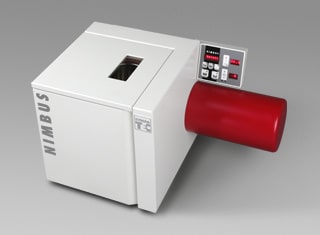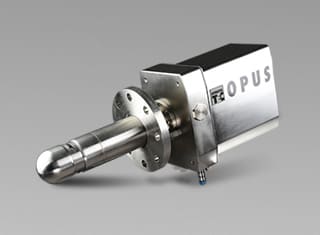Liquid dispersions with a high concentration of solid particles or droplets, often totally opaque, are typically found in production processes. Optical analysers would require a high degree of dilution. Dilution not only causes an extensive preparation effort but changes the original state of dispersion. Ultrasonic extinction provides an outstanding performance for particle size analysis of suspensions and emulsions. One of the major benefits of ultrasonic extinction is the ability to operate in highly concentrated mediums, which typically come along with wet process stages. A solid content between 5 and 50 % by volume is the typical range of concentration. These are perfect conditions for the sensors OPUS and NIMBUS in process and laboratory applications. They even may be applied at concentrations up to 70 % by volume – typical for paste-like particulate systems.
Using sound waves instead of light waves, suspension or emulsion analysis is independent of transparency and may be conducted in totally opaque disperse matter like water droplets in crude oil, ore slurries or even carbon particles in liquid pitch. Paints, sugar pastes or pharmaceutical suspension also belong to the regular field of application. Ultrasonic extinction allows a rugged and robust probe design that resists typical process conditions such as high temperatures, pressures or aggressive media and abrasive materials.
Ultrasonic extinction sensors
NIMBUS | Particle size and concentration analysis in laboratory
The lab instrument NIMBUS analyses manual samples from 300 ml to 1,000 ml in an easy and comfortable way. The compact system uses the OPUS-technology and consists of identical core components. Therefore the same measuring range from below 0.1 µm to 3,000 µm applies to the instrument. Lab applications are found e.g., in petroleum engineering during the analysis of oil sands or in anode production for aluminium smelting (characterisation of anode grade coke in liquid pitch).
OPUS | Particle size and concentration analysis in process environments
The ultrasonic extinction sensor OPUS analyses both the particle size distribution and the concentration of disperse phases in suspensions and emulsions in the range from less than 1 µm to 3,000 µm in real time. OPUS is designed as a stable process probe for high temperatures and pressures and can withstand chemical and mechanical stresses. In addition to a dustproof and splashproof IP65 version, OPUS is also available as an ATEX probe. The common communication protocols are available for the exchange of data with your process control system.












